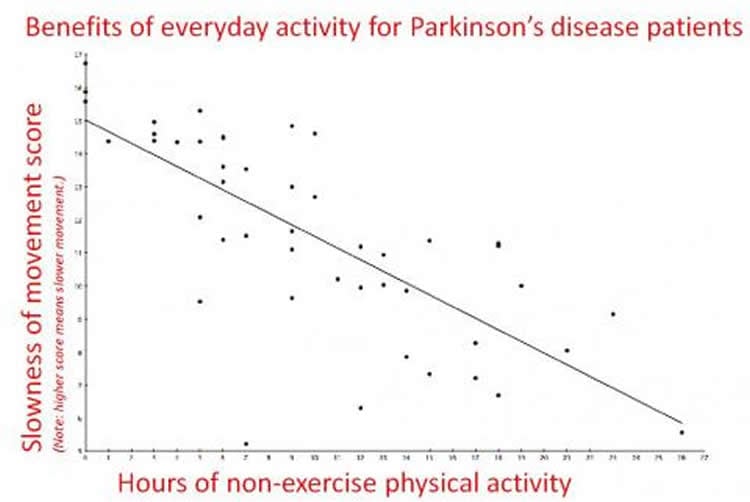New University of Michigan research finds people with Parkinson’s disease may want to consider attempting to do the dishes, fold the laundry and take strolls around the neighborhood in their quest to control their symptoms.
Parkinson’s patients often become sedentary because of motor symptoms such as gait, balance problems or falls, said study principal investigator Nicolaas Bohnen, M.D., Ph.D., director of the U-M Functional Neuroimaging, Cognitive and Mobility Laboratory.
Once patients feel unstable on their feet, they may develop a fear of falling and then get scared to do any activity at all. Bohnen’s team investigated whether participation in exercise, like swimming or aerobics, could help alleviate the motor symptoms that made these patients want to stay sedentary in the first place.
“What we found was it’s not so much the exercise, but the routine activities from daily living that were protecting motor skills,” Bohnen said. “Sitting is bad for anybody, but it’s even worse for Parkinson’s patients.”
The imaging study, now available online in Parkinsonism and Related Disorders, was conducted by U-M faculty who hold appointments in both radiology and neurology.
Researchers investigated the relationship between the duration of both non-exercise and exercise physical activity and motor symptom severity for 48 Parkinson’s disease patients over a 4-week period. They performed PET brain imaging to measure dopamine levels and used a questionnaire to learn about how physically active the patients were, including both exercise and non-exercise activity. They found that non-exercise physical activity was linked to less severe motor symptoms.
Although loss of dopamine is a key brain change for Parkinson’s patients, and has been thought to be the main reason why Parkinson’s patients become more sedentary, the researchers found non-exercise physical activity protected motor skills even among patients with differing levels of dopamine.

“This may have a big impact for Parkinson’s patients,” said co-author Jonathan Snider, M.D., clinical lecturer of neurology at the University of Michigan. “Not only worsening Parkinsonism but also increasingly sedentary behavior may explain more severe motor symptoms in advanced Parkinson’s disease.”
“I tell my patients to stand up, sit less, and move more,” said Bohnen, also professor of radiology and neurology at the University of Michigan, VA Ann Arbor Healthcare System staff physician and investigator in U-M’s Udall Center for Excellence in Parkinson’s Disease Research.
Additional authors: Martijn L.T.M. Müller, Ph.D., Vikas Kotagal, M.D., Robert A. Koeppe, Ph.D., Peter J.H. Scott, Ph.D., Kirk A. Frey, M.D., Roger L. Albin, M.D., all of U-M.
Funding: This research was funded by the Department of Veterans Affairs (grant I01RX000317), the Michael J. Fox Foundation and the National Institutes of Health (grants P01 NS015655 and RO1 NS070856). Support was also provided by the University of Michigan Udall Center of Excellence for Parkinson’s Disease Research (P50 NS091856-01).
Disclosure: The authors declare no conflict of interest relevant to this work.
Source: Haley Otman – University of Michigan
Image Source: The image is credited to The researchers/University of Michigan
Original Research: Abstract for “Non-exercise physical activity attenuates motor symptoms in Parkinson disease independent from nigrostriatal degeneration” by Jonathan Snider, Martijn L.T.M. Müller, Vikas Kotagal, Robert A. Koeppe, Peter J.H. Scott, Kirk A. Frey, Roger L. Albin, and Nicolaas I. Bohnen in Parkinsonism and Related Disorders. Published online August 25 2015 doi:10.1016/j.parkreldis.2015.08.027
Abstract
Non-exercise physical activity attenuates motor symptoms in Parkinson disease independent from nigrostriatal degeneration
Objective
To investigate the relationship between time spent in non-exercise and exercise physical activity and severity of motor functions in Parkinson disease (PD).
Background
Increasing motor impairments of PD incline many patients to a sedentary lifestyle. We investigated the relationship between duration of both non-exercise and exercise physical activity over a 4-week period using the Community Health Activities Model Program for Seniors (CHAMPS) questionnaire and severity of clinical motor symptoms in PD. We accounted for the magnitude of nigrostriatal degeneration.
Methods
Cross-sectional study. PD subjects, n = 48 (40 M); 69.4 ± 7.4 (56–84) years old; 8.4 ± 4.2 (2.5–20) years motor disease duration, mean UPDRS motor score 27.5 ± 10.3 (7–53) and mean MMSE score 28.4 ± 1.9 (22–30) underwent [11C]dihydrotetrabenazine (DTBZ) PET imaging to assess nigrostriatal denervation and completed the CHAMPS questionnaire and clinical assessment.
Results
Bivariate correlations showed an inverse relationship between motor UPDRS severity scores and duration of non-exercise physical activity (R = −0.37, P = 0.0099) but not with duration of exercise physical activity (R = −0.05, P = 0.76) over 4 weeks. Multiple regression analysis using UPDRS motor score as outcome variable demonstrated a significant regressor effect for duration of non-exercise physical activity (F = 6.15, P = 0.017) while accounting for effects of nigrostriatal degeneration (F = 4.93, P = 0.032), levodopa-equivalent dose (LED; F = 1.07, P = 0.31), age (F = 4.37, P = 0.043) and duration of disease (F = 1.46, P = 0.23; total model (F = 5.76, P = 0.0004).
Conclusions
Non-exercise physical activity is a correlate of motor symptom severity in PD independent of the magnitude of nigrostriatal degeneration. Non-exercise physical activity may have positive effects on functional performance in PD.
“Non-exercise physical activity attenuates motor symptoms in Parkinson disease independent from nigrostriatal degeneration” by Jonathan Snider, Martijn L.T.M. Müller, Vikas Kotagal, Robert A. Koeppe, Peter J.H. Scott, Kirk A. Frey, Roger L. Albin, and Nicolaas I. Bohnen in Parkinsonism and Related Disorders. Published online August 25 2015 doi:10.1016/j.parkreldis.2015.08.027






